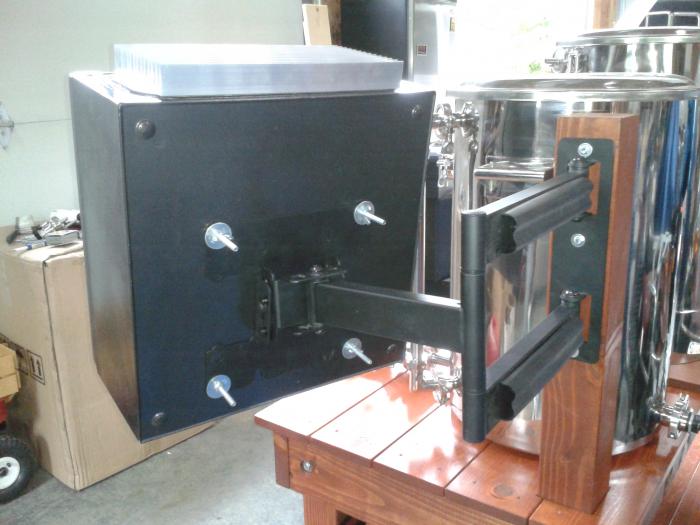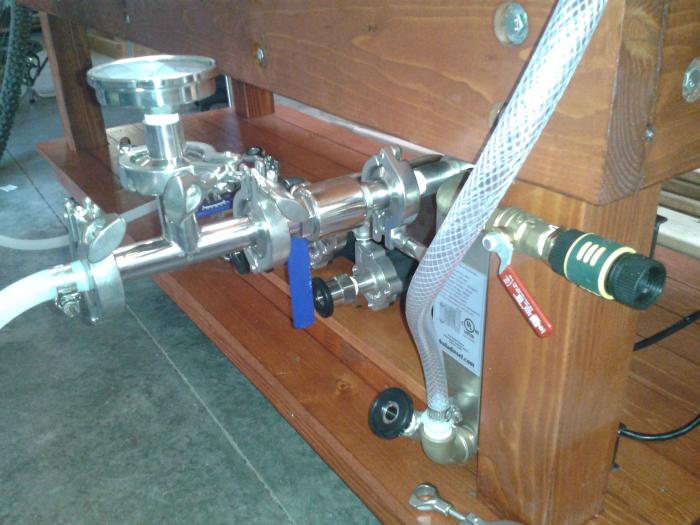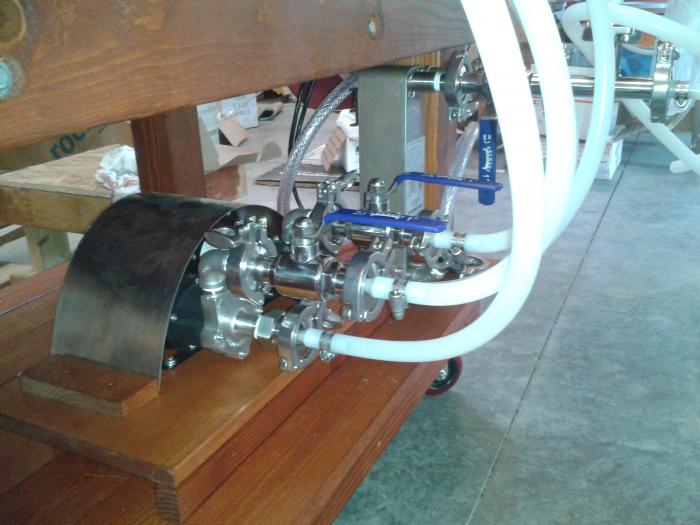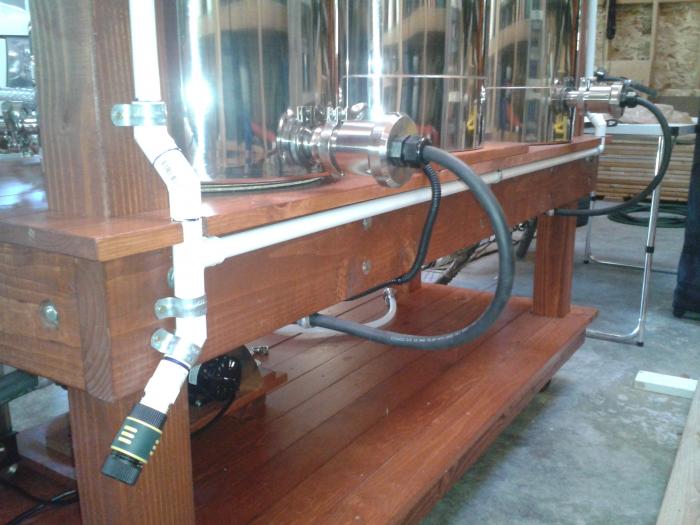I finally did a couple of test runs on the new system with water over the past week. One of the PID controllers went bad and Aubers replaced it within just a few days. Then I noticed one of the Auber RTD sensor tri-clover fittings was leaking so they will be sending out a replacement today. Aubers has been top notch on customer service!
Here are my inital thoughts and comments on the Stout and electric system:
1) The butterfly valves bottom out on the brew stand so I had to raise the MLT and HLT. You would think that butterfly valves and kettles from Stout tanks would work together...
2) I definitly cannot do a 5 gallon batch with the 30 gal kettle. The RTD sensor would be above the wort level and the element would only have a couple of inches of wort over it. So, I had a 1.5" tri-clover bung welded onto the back of my old keggle and I installed a weldless 1/2" NPT thermowell on the side to use for batches smaller than 10 gallons. Cheap and easy. Iwould think a 25 gal BK would be a popular option for people that want to brew 1/2 bbl batches. A 20 gal would have been too small for me and this 30 gal is too big.
3) Autotune on the 2352 PID worked like a champ. It only took about 15 mintues to do it's thing and it works it's magic very well.
4) I wish there was a way to hang the kettle lids. I needed an extra table just to put the lids on.
5) I have a 5,500w element in the HLT which works great. It takes about 40minutes to heat up 20 gallons of 62 degree water to mash strike temps. I originally had a 4,500w element in the BK but found that it didn't have a very vigorous boil, even with the PID set to 100% in manual mode. I switched to a 5,500w element and it seems to do a better job, plus this element is a couple of inches longer so it reaches out further. It boils just fine but it doesn't really stir up the wort like having propane heat blasting the entire bottom did. There is kind of a dead zone on the opposite side of the kettle from the element if that makes sense. Kind of like a dead zone inside of the hop spider. Regardless, it brings it to a boil which is what really matters.
6) My original plan was to collect all of the plate chiller cooling water into the HLT for use in cleaning the system when done brewing. Even with the 30 plate Dudadiesel chiller, I quickly fill up the HLT when trying to cool 10 gallons of wort down. So, I need to come up with an easy way to get rid of the cooling water once the HLT is full. I may just scrap trying to collect it at all and run a garden hose out into the lawn like I did before. I really don't want to have to worry about switching stuff over in the middle of moving wort into the fermenters.
7) I really like how the water plumbing turned out. I simply reach over and turn a valve to fill up the BK or HLT. I put a quick disconnect on this and also near the plate chiller cooling water inlet.
8) I have had no priming issues with the center inlet Chugger pumps. I had a lot of priming issues with my side inlet March pump, even with a Watts vent on the outlet. I know the Chugger and March specs. are similar, but it seems like the Chugger's pump at a higher rate.
9) The 3/8" (I believe that's the size) HERM's coil restricts flow to a point where I should be able to simply leave the outlet valve wide open during mash recirculation. I was worried that I would have to constantly mess with this valve to obtain a certain recirculation rate.
10) The whirpool inlet on the BK is practically worthless. I had about 16 gallons of water in there and had short hose runs to/from the Chugger pump. It may eventually move junk to the center but I gave up after 5 minutes. I may still use this inlet to recirculate through the chiller after boiling. I have the hop strainer from Chad that will keep most of the hops out anyway.
11) I am glad I went with two Aubers timers. It nice to have one dedicated to the boil kettle and the other for either hop additions (if doing a single batch) or as a mash timer when doing back-to-back batches.
12) I would give the overall quality of the Stout kettles a B grade. Most of the inlets, outlets, ports, etc. are not lined up with each other horizontally and/or they are welded to the kettle at a slight angle. The angle is really noticable when you have the length of a valve, tee, and then hose barb coming out. The false bottom was slightly warped but nothing I couldn't fix with a little muscle. The thing that really peeves me is having to raise the MLT and HLT for the ball valve body to clear the stand.
13) The EPDM tri-clover gaskets from brewershardware really stick to the tri-clovers. There were a couple of times I really had to pry to get the connection apart. They are supposed to have a heat range up to 300 deg so I'm not sure what is going on. I may see if brewershardware will switch these out for the silicone ones.
I think that's it for now. I plan on brewing for real this weekend. Off to start on the yeast starter...









